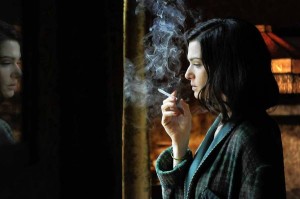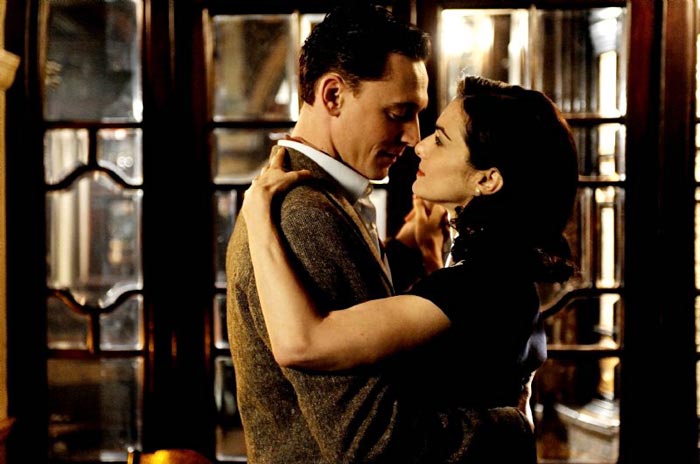Movie Review: “The Deep Blue Sea” — A Feast for the Eye and the Mind
While The Deep Blue Sea may be a throwback to another era, director Terence Davies has used his masterful style to engage the audience cinematically and psychologically in an elegant, circular structure.
The Deep Blue Sea. Directed by Terence Davies. At the Kendall Square and West Newton Cinema
By Tim Jackson
Terence Davies’s new film The Deep Blue Sea is an exquisite re-invention of Terence Rattigan’s 1952 stage play of the same name. Both play and film begin with Hester Collyer deciding to commit suicide via gas. The first act of Rattigan’s play is all exposition revolving around the details of Hester’s doomed love affair. Married to an older, wealthy judge, Sir William Collyer (Simon Russell Beale), Hester has entered into a passionate affair with a n’er-do-well younger man, Freddie Page, an ex-RAF pilot and a bit of a drinker. This affair has led to her current state of desperation.
In the play, Rattigan explains the situation in clear, crisp dialogue in the first act. Davies takes the same material, eliminates the linear exposition, and draws us into Hester’s plight with flashbacks that pull us in emotionally and psychologically. Where Rattigan’s artful writing effortlessly reveals characters and conflicts, Davies paints with light, adding imaginative visuals steeped in the colors, textures, spaces, and manners of post-war Britain.
The film’s screenplay stays true to the spirit of the original, but Davies’s direction uses silences, gestures, furtive glances, and subtle gestures to reveal character. It requires nimble actors to effectively explore this nuanced emotional terrain—which veers from the repressed to overwrought. To the very end of the movie, our sympathies for the participants in this troubled triangle shift from one character to the next. Hester, as played by Rachael Weiss, in possibly her best role, is on camera continuously. Hester has made the possibly unfortunate choice of sacrificing everything for a new love with whom she has experienced, for the first time, the passion of physical love. Yet she is damaged, lost, and desperate.
As Freddie, Tom Hiddleston is all shifting emotions, charming and smitten one minute, angry, dissipated, and crass the next. Having been a crack test pilot in the war, he faces an uncertain future. It is William, Hester’s husband who is the most surprising of the three. Acted with perfection by the great stage actor, Simon Russell Beale, William is comical as a son, noble as a jilted husband, and deeply touching as the man who cares for and understands his sad wife.
To add dimension to William, Davies has invented some new scenes to reveal how Hester’s erudite and prudish husband dotes on his mother like a puppy. In a riotous lunch scene, the mother, the sour matriarch of an upper-class family, faces off with young Hester much to William’s dismay. Hester declares the importance of passion in one’s life, to which mother responds, “Passion always leads to something ugly. I prefer guarded enthusiasm. It’s safer.” Hester abruptly excuses herself and heads upstairs to call her lover. The camera shoots behind her head, and we know what’s coming next. William has entered the room. “Whom else do you call ‘darling,'” asks her gentle husband upon overhearing Hester’s ill-timed conversation with her lover. The plot is in motion.
The film cuts back again to her first meeting with Freddie while on holiday. He dotes on her, and she is soon overwhelmed by the erotic attraction. Her husband, past his sexual prime, is no match for this new kind of love, which he condemns simply as lust. As a lover, Freddie has awakened Hester’s passion but upon hearing about her first attempt at suicide, he is utterly dismissive. This pushes Hester deeply into depression, and Freddie, who hit his prime as a war hero, is no help emotionally. He refuses to understand Hester’s seemingly petty urge for self-destruction. Her husband’s attempts to save her with heartbreaking, fatherly kindness are thwarted. She is unwilling to return her former life. None in this triangle will find what is best for him or herself. Hester’s amour fou drives a downward spiral.
Davies begins the film with an impassioned rendition of Samuel Barber’s Concerto for Violin and Orchestra, Op 14, which becomes a powerful emotional motif, though the film actually unfolds mostly in silence. As he did in his 1988 masterpiece Distant Voices, Still Lives, there are regular pub sings where locals raise their voices in song. These songs add atmosphere, comic relief, and illuminate character. In Distant Voices, Still Lives pub singing is prominent and heartbreaking. Here he employs that device to similar effect. Davies’s rich visuals, his examination of faces and gestures, the alternation of music and silence, and his clever juxtapositions of scenes and motifs become a visual symphony.
Both music and memory are essential to the director’s style. He moves us forward and backward in time, suggesting that the camera is recording wayward memories rather than an ordered sequence of events. Memory, Davies explains, is always in the present. He attempts to consolidate long gaps of time and lengthen shorter moments to encourage us to savor the emotional impact of a passing event. These flickers of time settle on the trivial: a gaze, a glance, cigarette smoke. His mis-en-scene is sensuous and impressionistic. Florian Hoffmeister’s rich cinematography, filtered through Davies’ powerful visual memory of Britain in the 1950s, memorably revives the character of post-war Britain, a world where dark wood and leather interiors are illuminated with small pools of golden lamplight.
Rattigan’s play is in the tradition of 1940’s and 50’s domestic “weepies” such as Douglas Sirks’s All That Heaven Allows or the Noel Coward/David Lean film Brief Encounter. While The Deep Blue Sea may be a throwback to another era, Davies has used his masterful style to engage the audience cinematically and psychologically through arranging telling details in an elegant, circular structure. As he did with Gillian Anderson in The House of Mirth, he brings Rachael Weiss to a higher level. The Deep Blue Sea is a feast for the eyes and the mind from a director whose subtle touch and individual style is all too rare a treat for film lovers.
Tagged: 1950s, British, Film, Rachel Weisz, Simon Russell Beale, Terrence Davies


